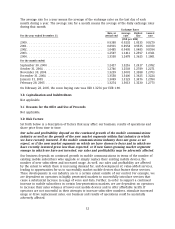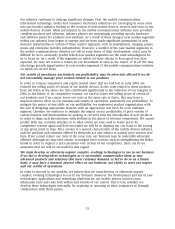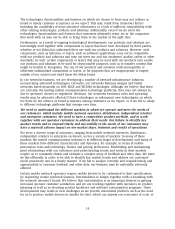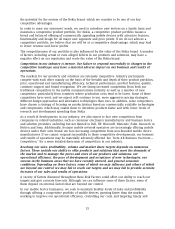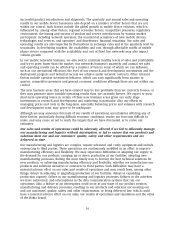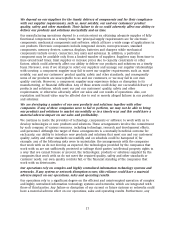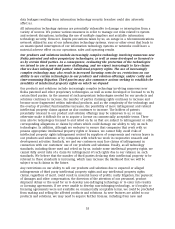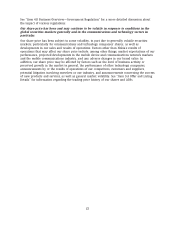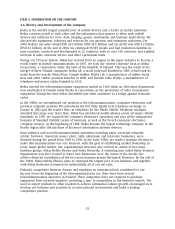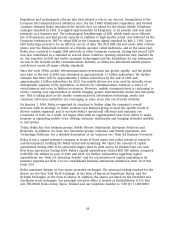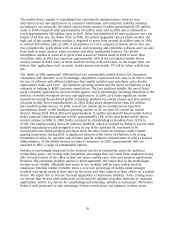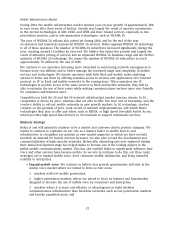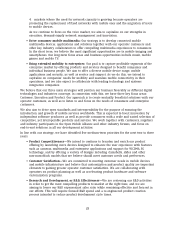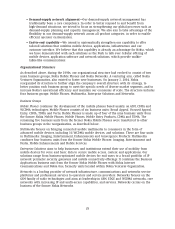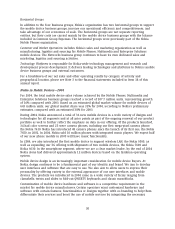Nokia 2004 Annual Report Download - page 22
Download and view the complete annual report
Please find page 22 of the 2004 Nokia annual report below. You can navigate through the pages in the report by either clicking on the pages listed below, or by using the keyword search tool below to find specific information within the annual report.certain that future studies, irrespective of their scientific basis, will not suggest a link between
electromagnetic fields and adverse health effects that would adversely affect our sales and share
price. Research into these issues is ongoing by government agencies, international health
organizations and other scientific bodies in order to develop a better scientific and public
understanding of these issues.
Currently, we and several other mobile device manufacturers, distributors and network operators
have been named as defendants in a series of class action suits filed to various US jurisdictions.
These cases were consolidated before a US federal district court in Baltimore, Maryland, United
States. The suits allege that the use of mobile phones without a headset poses a health risk. The
cases were dismissed on March 5, 2003, on the theory that the issues raised are primarily within
the jurisdiction of the Federal Communications Commission, not the courts. The dismissal is now
on appeal. In addition, we and other mobile device manufacturers and network operators have
been named as defendants in five lawsuits by individual plaintiffs who allege that radio emissions
from mobile phones caused or contributed to each plaintiff’s brain tumor. Those cases are before
the District of Columbia courts. See ‘‘Item 8.A.7—Litigation’’ for a more detailed discussion of these
lawsuits.
Although Nokia products and solutions are designed to meet all relevant safety standards and
recommendations globally, no more than a perceived risk of adverse health effects of mobile
communications devices could adversely affect us through a reduction in sales of mobile devices
or increased difficulty in obtaining sites for base stations, and could have a negative effect on our
reputation and brand value as well as harm our share price.
An unfavorable outcome of litigation could materially impact our business, financial
condition or results of operations.
We are a party to lawsuits in the normal course of our business. Litigation can be expensive,
lengthy and disruptive to normal business operations. Moreover, the results of complex legal
proceedings are difficult to predict. An unfavorable resolution of a particular lawsuit could have a
material adverse effect on our business, operating results, or financial condition.
Changes in various types of regulation in countries around the world could affect our
business adversely.
Our business is subject to direct and indirect regulation in each of the countries in which we, the
companies with which we work or our customers do business. As a result, changes in various
types of regulations applicable to current or new technologies, products or services could affect
our business adversely. For example, it is in our interest that the Federal Communications
Commission maintains a regulatory environment that ensures the continued growth of the
wireless sector in the United States. In addition, changes in regulation affecting the construction of
base stations and other network infrastructure could adversely affect the timing and costs of new
network construction or expansion and the commercial launch and ultimate commercial success of
these networks.
Moreover, the implementation of new technological or legal requirements, such as the
requirement in the United States that all handsets must be able to indicate their physical location,
could impact our products and solutions, manufacturing or distribution processes, and could affect
the timing of product and solution introductions, the cost of our production, products or solutions
as well as their commercial success. Finally, export control, tariff, environmental, safety and other
regulation that adversely affects the pricing or costs of our products and solutions as well as new
services related to our products could affect our net sales and results of operations. The impact of
these changes in regulation could affect our business adversely even though the specific
regulations do not always directly apply to us or our products and solutions.
21



